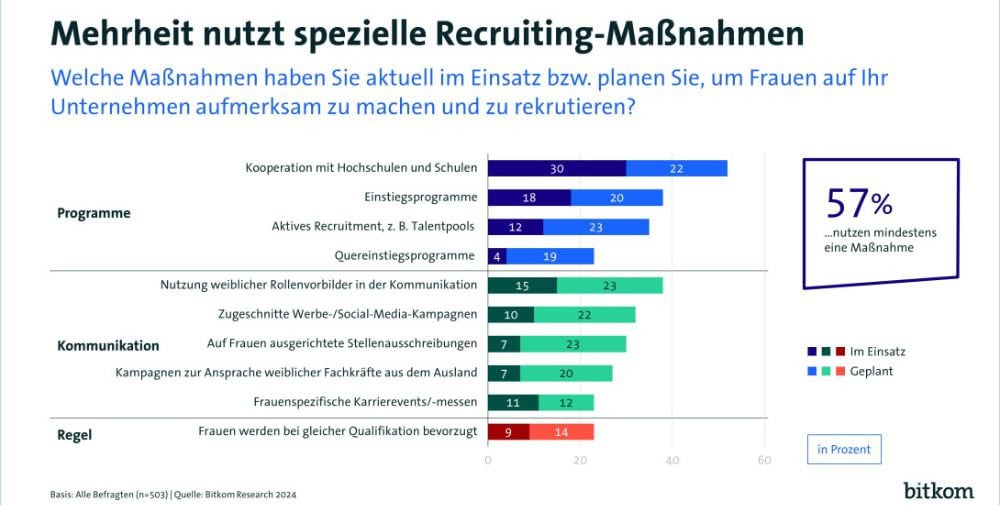
“Schools are the only place that every girl attends. This is where the course is set for later study and career choices. This makes it all the more important to arouse interest in digital professions in schools and to break down social stereotypes. Digitalization and technology have no gender. Girls should be introduced to digitalization from an early age and be made enthusiastic about it. They must be given the same opportunities to pursue their curiosity about technology as boys. This also includes making the many inspiring female role models that already exist today more visible,” says Bitkom President Dr Ralf Wintergerst.
One fifth already use entry-level programs for women in recruiting
Among the most popular recruiting measures are entry-level programs such as traineeships to help young women start their careers, which 18 percent of companies use, and the use of female role models in communication at 15 percent. Active recruitment, for example via talent pools, has been practiced by 12 percent to date. This is followed by appearances at women-specific career fairs and events by 11 percent of IT companies, as well as advertising or social media campaigns tailored to women and girls, which are used by one in ten IT companies (10 percent). The rule of giving preference to women with the same qualifications exists in 9 percent of IT companies.
Special measures to specifically promote the careers of female employees are also widespread in many IT companies: 67 percent use at least one such measure and a further 31 percent are planning them. On average, every IT company has a total of three measures in place to promote women in the company. Measures to improve the work-life balance are the most common: mobile working (59%) and more family-friendly working conditions, such as flexible working time models (39%). A stay-in-touch program during parental leave is used by 26 percent and job sharing by 16 percent. When it comes to job support, around a third (35%) offer further training, and 21% offer mentoring. A quarter (25 percent) of IT companies also focus on raising awareness and educating staff and managers. There are internal women’s networks in 12 percent of IT companies.
A quarter doubt the seriousness and impact of measures
On the other hand, a quarter of the industry is generally skeptical about such measures: 23 percent of IT companies say that measures to promote women do not bring about any change anyway. Just as many (23 percent) believe that the advancement of women is often only a pretext and that nothing changes in practice. Wintergerst: “Those who only promote women half-heartedly or as image cultivation are not only making a mistake socially, but also economically. Experience shows that companies become more attractive to women through appropriate measures and are more efficient and successful in the long term with a diverse workforce.”
The commitment to actually wanting to change something is expressed in concrete objectives. However, only 29 percent of IT companies have currently set themselves internal targets to increase the proportion of women: 20 percent general targets, a further 9 percent with defined targets and timetables. 15 percent are currently planning such targets and 27 percent are discussing them. For just under a quarter (23%), however, the formulation of internal targets for the advancement of women is not currently an issue. Most of these companies cite not having enough qualified female applicants (74%) or other priorities (37%) as the reason for not having set any targets to date. “Clear goals create commitment. Without them, it is difficult to significantly increase the proportion of women. Despite the numerous crises in recent years, companies need to think about how they can attract and retain women for open positions. By benefiting from the different skills, perspectives and experiences of employees, companies can become more resilient and competitive through a diverse workforce,” says Wintergerst.
The issues of equality and career planning are mostly at the executive level
Companies are well aware of how important it is to attract more women: 66 percent say that without women, the industry is gambling away its future, and 68 percent consider it impossible to close the IT skills gap without women. On the other hand, three quarters (73%) are also self-critical and believe that the IT sector underestimates the potential of women.
This is also reflected in the naming of specific responsibilities: Only half of the companies (50 percent) have designated personnel responsibilities for the topics of equality and career planning to date. At a total of 34 percent, the topic is anchored in the management, at 20 percent in the HR department and at 1 percent with equal opportunities or women’s representatives or diversity officers. On the other hand, in 47% of companies, no one is responsible for these issues at all. Wintergerst: “Naming clear responsibilities and contact persons gives the goals a face and makes a significant contribution to ensuring that equality and the advancement of women are not just seen as a short-term nice-to-have, but as an important part of a long-term corporate strategy.”
Women in IT: the majority of the industry sees itself as lagging behind worldwide
In an international comparison, Germany’s IT companies recognize that they have a lot of catching up to do. When it comes to equality and increasing the proportion of women, a large majority see the German IT sector as lagging behind: For 60 percent, the German IT sector is one of the international laggards, while a further 20 percent even say the sector has missed the boat. Only 15 percent see the sector as one of the global pioneers, with just 2 percent at the top. According to Bitkom calculations, the proportion of women in the German IT sector is 30 percent.
Hurdles lie in re-entry, old role models and care infrastructure
From the companies’ point of view, the reasons for the rather low proportion of women among employees in the German IT sector are manifold and can be found in companies, politics and, to some extent, in social structures. At 66%, obstacles to women re-entering the workforce, such as a lack of training opportunities during absences and traditional role models in companies (64%) are seen as the main reasons for the low proportion. Within companies, a lack of networks for women (50 percent), insufficient awareness among managers with personnel decisions (44 percent) and the phenomenon of the “glass ceiling” (43 percent) are seen as obstacles.
But politicians are also seen as having a responsibility. For example, 60 percent of IT companies see the lack of infrastructure to care for children or relatives in need of care as an obstacle to increasing the proportion of women. 56 percent observe obstacles to lateral entry such as clichéd recommendations for further training from employment agencies. Almost every second IT company (49%) cites clichéd training or career guidance at schools as a reason. “We have to say goodbye to outdated and simply inaccurate role clichés. They block important development opportunities for women and girls in business and society. It’s not just about more technological innovation and greater economic success through more diversity, but also simply about more digital participation and equal participation in shaping digitalization,” says Wintergerst.
Half (50 percent) of IT companies also see poorer self-marketing by women as a barrier to a career in IT. 42 percent speak of insufficiently qualified female applicants. A third (33%) believe that women’s lack of interest in IT professions is the reason for the low proportion of women, while 22% believe that women are less interested in working in the IT sector than men. Wintergerst: “In the competition for skilled workers, companies must make an effort and create a working environment in which women enjoy working.”
Joint effort required from companies, politicians and society
In total, almost half of IT companies see themselves as having a duty, but the majority would also like more support from politicians: 51% of IT companies say that they themselves are responsible for increasing the proportion of women. 61 percent are of the opinion that politicians should do more to promote women in IT. From Bitkom’s point of view, in addition to internal company measures such as targets, personnel responsibilities and training and support offers for women, politicians need to invest more in the support infrastructure and an education policy that specifically promotes the interest of girls and young women in IT topics. This includes, for example, stereotype-free career guidance and further training advice for girls and women, more attractive training and study curricula and compulsory computer science lessons throughout Germany.
“With a large number of small companies and some big players, the German IT sector is very heterogeneous. Companies therefore have very different financial and human resources at their disposal to promote the advancement of women internally. At the same time, socialization at home, school and university plays an important role in later career choices. The challenges that IT companies face on the path to greater diversity are complex. This makes it all the more important not to put the issue on the back burner and to tackle it with a package of measures,” says Wintergerst. Bitkom and other partners are involved in the #SheTransformsIT initiative to inspire women to pursue careers in the digital economy and to support politicians and companies in better promoting female specialists and managers. The interdisciplinary alliance of business, science, politics and civil society is committed to empowering girls and women in the digital transformation.
– – – – – –
Further links
👉 www.bitkom.org
Graphic: Bitkom




